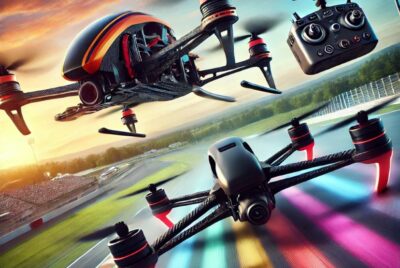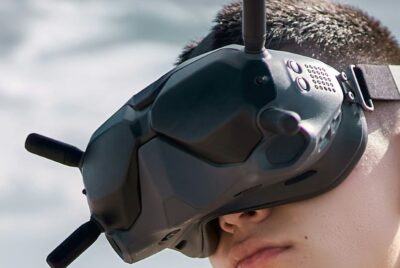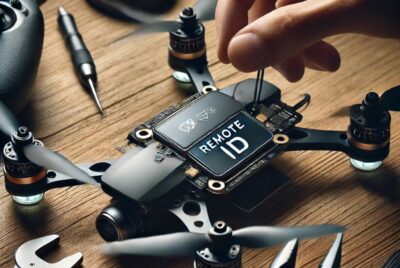FPV Drone Goggles – The Ultimate Guide
Hey there! Some links on this page are affiliate links which means that, if you choose to make a purchase, I may earn a small commission at no extra cost to you. I greatly appreciate your support! Please see our Disclosure to learn more.
Introduction
In the world of FPV (first-person view) drone flying, goggles are your window into the sky. They provide an immersive, real-time view from your drone’s camera, allowing you to fly as if you were in the cockpit. Choosing the right goggles is crucial for a comfortable, enjoyable, and successful FPV experience. In this guide, we’ll dive deep into everything you need to know about FPV drone goggles.
What are FPV Drone Goggles?
FPV drone goggles are specialized headsets that receive a live video feed from your drone’s onboard camera, providing an immersive first-person view for piloting. Here’s what sets them apart:
Immersive First-Person View
Unlike traditional line-of-sight flying, FPV goggles put you in the pilot’s seat, making you feel like you’re soaring through the sky. This immersive perspective enhances situational awareness and control.
FPV Drone Goggles – Real-Time Video Feed
FPV goggles receive a low-latency video signal from your drone, typically transmitted over the 5.8GHz frequency band. This real-time feed allows you to react quickly and fly with precision.
Head Tracking and Other Features
Many modern FPV goggles include head tracking, which allows you to control your drone’s camera angle by simply moving your head. Other common features include DVR recording, HDMI input, and diversity receivers for improved signal reception.
Types of FPV Drone Goggles
FPV goggles come in several main form factors, each with its own advantages and trade-offs:
Box Goggles
- Pros and Cons of Box Goggles – Box goggles offer a large screen and wide field of view, providing an immersive experience. However, they can be bulky and less portable than other designs.
- Popular Box Goggle Models – Examples include the Fat Shark Dominator series, Skyzone Sky02X, and Eachine EV800D.
Compact Goggles
- Pros and Cons of Compact Goggles – Compact goggles are lightweight, portable, and low-profile, making them ideal for racing and freestyle flying. However, they may have smaller screens and a narrower field of view compared to box goggles.
- Popular Compact Goggle Models – Examples include the Fat Shark HDO, DJI FPV Goggles, and Orqa FPV One.
Hybrid Goggles
- Combining the Best of Both Worlds – Hybrid goggles aim to offer the immersion of box goggles with the portability of compact designs. They often feature modular faceplates and removable screens.
- Examples of Hybrid Goggles – The Skyzone Sky04X and Fat Shark Attitude V6 are notable hybrid goggle models.
Key Features to Look for in FPV Drone Goggles
When shopping for FPV drone goggles, keep an eye out for these essential features:
Display Resolution and Type
Look for goggles with high-resolution displays (720p or higher) for a crisp, detailed image. OLED screens offer superior contrast and color compared to LCD.
Field of View (FOV)
A wider FOV provides a more immersive experience and better situational awareness. Look for goggles with a diagonal FOV of at least 30 degrees.
Interpupillary Distance (IPD) Adjustment
Adjustable IPD ensures that the goggles’ lenses align properly with your eyes for a clear, comfortable image. Make sure the goggle’s IPD range fits your needs.
FPV Drone Goggles – Receiver Diversity
Diversity goggles use two receivers and antennas to improve signal reception and reduce breakup. This is especially useful in challenging RF environments.
DVR Recording
Built-in DVR allows you to record your FPV flights directly on the goggles for later review and sharing. Look for models with high-capacity storage and adjustable bitrates.
HDMI Input
An HDMI input allows you to use your goggles with external video sources like action cams or simulators, adding versatility to your setup.
Head Tracking
Head tracking allows you to control your drone’s camera angle by moving your head, freeing up your hands for other controls. It’s a useful feature for cinematography and exploring.
Analog vs. Digital FPV Drone Goggles
One of the biggest decisions when choosing FPV drone goggles is whether to go with an analog or digital video system. Here’s what you need to know:
Understanding Analog Video Transmission
- 5.8GHz Frequency Bands – Analog FPV systems transmit video over the 5.8GHz frequency band, which is divided into several channels across multiple bands (e.g., A, B, E, F).
- Advantages and Disadvantages of Analog – Analog offers low latency, affordability, and compatibility with a wide range of drones. However, it’s prone to interference and has lower image quality compared to digital.
The Rise of Digital HD Systems
- Benefits of Digital Video – Digital FPV systems like DJI FPV and Fat Shark Byte Frost offer high-definition video, improved range, and better signal penetration. They deliver a crisp, detailed image with less breakup.
- Leading Digital FPV Systems – DJI FPV and Fat Shark Byte Frost are two of the most popular digital FPV systems, each with its own ecosystem of goggles, transmitters, and cameras.
Choosing Between Analog and Digital
The choice between analog and digital depends on your budget, the drones you fly, and your personal preferences. Analog remains popular for its affordability and broad compatibility, while digital is gaining traction for its superior image quality and reliability.
Setting Up and Using FPV Drone Goggles
Once you’ve got your hands on a pair of FPV goggles, it’s time to set them up and start flying. Here’s a quick guide:
Connecting to Your Drone
- Binding Receivers – To establish a connection between your goggles and drone, you’ll need to bind the receiver in the goggles to the video transmitter (VTX) on the drone. This typically involves putting both devices into bind mode and letting them find each other.
- Choosing Channels and Bands – Analog FPV systems use specific channels and bands to transmit video. Make sure your goggle receiver and drone VTX are set to the same channel and band for a clear signal.
Adjusting Display Settings
- Brightness, Contrast, and Color – Use the goggle’s on-screen display (OSD) menu to fine-tune the brightness, contrast, and color settings for the best possible picture.
- Field of View and Aspect Ratio – Adjust the field of view and aspect ratio to your liking. A larger FOV will be more immersive, while a narrower FOV may help with precision flying.
Using DVR and Other Features of FPV Drone Goggles
Get familiar with your goggle’s DVR controls for recording and playback. Explore other features like head tracking, image enhancement, and custom OSD layouts.
Proper Eye Positioning and Focus
To get a clear, comfortable image, it’s important to position your eyes correctly in the goggles. Adjust the IPD and focus the lenses until the picture is sharp and your eyes are relaxed.
Comfort and Ergonomics of FPV Drone Goggles
Comfort is key for long FPV flying sessions. Here’s how to ensure your goggles fit well and feel good:
Importance of a Comfortable Fit
Ill-fitting goggles can cause eye strain, headaches, and fatigue. Taking the time to dial in a comfortable fit will greatly enhance your FPV experience.
Foam Padding and Face Plates
Look for goggles with soft, breathable foam padding that conforms to your face without excessive pressure. Some models offer various thickness pads or interchangeable face plates for a custom fit.
Headstrap Adjustment
A well-adjusted headstrap distributes the weight of the goggles evenly and securely. Dial in the tightness so the goggles stay in place without causing discomfort.
Ventilation and Anti-Fog Features
Goggles with proper ventilation and anti-fog coatings help prevent lens fogging and overheating during intense flying sessions. Look for models with built-in fans or vents.
Wearing Glasses with FPV Drone Goggles
If you wear glasses, look for goggles with adjustable diopters or space to accommodate your frames. Some goggles even have removable lens inserts for custom corrective lenses.
External Modules and Accessories For FPV Drone Goggles
You can expand the capabilities of your FPV goggles with various external modules and accessories:
Receiver Modules
- Diversity and Rapid-Switching Modules – External receiver modules can add diversity or rapid-switching capabilities to your goggles for improved signal reception.
- Patch and Helical Antennas – Upgrading to high-gain patch or helical antennas can boost your range and penetration in challenging environments.
Battery Packs and Power Banks
External battery packs or power banks can greatly extend your goggle’s runtime, letting you fly for hours without worrying about a dead battery.
External DVR and HDMI Modules
If your goggles lack built-in DVR or HDMI input, you can add these features with external modules that connect to the headset.
Lens Inserts and Diopters
Custom lens inserts and diopters can be used to correct vision or change the field of view and magnification of your goggles.
Maintaining and Troubleshooting FPV Drone Goggles
To keep your FPV goggles in top shape and deal with any issues that arise, follow these tips:
Cleaning Lenses and Screens
Regularly clean your goggle lenses and screens with a microfiber cloth and gentle cleaning solution to maintain a clear, smudge-free image.
Updating Firmware of FPV Drone Goggles
Keep your goggle’s firmware up to date for the latest features, bug fixes, and performance improvements. Check the manufacturer’s website for update instructions.
Replacing Foam Padding
Over time, the foam padding on your goggles may wear out or become less comfortable. Most goggles allow you to easily replace the foam pads for a fresh fit.
Diagnosing and Fixing Common Issues
If you encounter problems like a fuzzy image, signal drop-outs, or unresponsive controls, consult your goggle’s manual or online forums for troubleshooting tips and solutions.
The Future of FPV Drone Goggles
As FPV drone technology continues to evolve, so too will the goggles we use to fly them. Here are some exciting developments on the horizon:
Advancements in Display Technology
Expect to see higher-resolution displays, faster refresh rates, and improved color accuracy in future FPV goggles. MicroLED and other emerging display tech could greatly enhance image quality.
FPV Drone Goggles – Integration with Augmented Reality
In the future, FPV goggles may integrate with augmented reality systems to overlay flight data, navigation aids, and other information directly onto your view.
Wireless Streaming and Sharing
Next-gen goggles may allow for wireless streaming and sharing of your FPV feed to external devices and audiences, opening up new possibilities for immersive shared experiences.
Improved Ergonomics and Customization
Expect to see goggles with even better comfort features, more adjustability, and modular designs that allow for extensive personalization and upgrades.
Conclusion
FPV drone goggles are the key to unlocking the full potential of immersive, first-person flight. From the wide field of view and detailed image of box goggles to the portability and low latency of compact models, there’s a perfect pair of goggles out there for every pilot and flying style.
When choosing your goggles, consider key features like display resolution, receiver diversity, IPD adjustment, and head tracking. And don’t forget about the importance of comfort – a well-fitting headset can make all the difference in your FPV experience.
As you explore the world of FPV, remember that your goggles are a central part of your setup that will grow and evolve with you. With the right care, upgrades, and accessories, a quality pair of FPV goggles can be your trusty companion for years of breathtaking flights and unforgettable aerial adventures.
So strap on your headset, fire up your drone, and get ready to see the world from a whole new perspective. The sky’s the limit!
Frequently Asked Questions about FPV Drone Goggles
- Can I wear glasses while using FPV goggles?
Many FPV goggles can accommodate glasses, either by providing space for the frames or by using adjustable diopters or lens inserts. However, it’s best to check the specific model’s compatibility before purchasing. - What’s the difference between LCD and OLED displays in FPV goggles?
OLED (organic light-emitting diode) displays offer superior contrast, deeper blacks, and more vibrant colors compared to traditional LCD screens. However, they also tend to be more expensive. - Are FPV goggles compatible with all drones?
Not all FPV goggles are universally compatible with every drone. It’s important to make sure your goggles are compatible with your drone’s specific video transmission system and frequency. - How do I know if my FPV goggles have a diversity receiver?
Goggles with diversity receivers will have two antenna connections, one for each receiver. Non-diversity goggles will only have a single antenna port. - Can I use FPV goggles for non-drone applications?
Yes, many FPV goggles can be used for other applications beyond drones, such as FPV racing cars, boats, or even ground stations for other types of remote-controlled vehicles. As long as the video feed is compatible with the goggles’ receiver, you can use them for a variety of FPV purposes.




